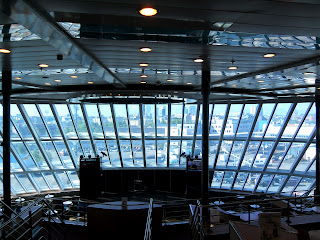Let's get familiar - in the three blog languages - with ships! Do you know for example what the front of a ship is called - or the right side (seen from the rear)?
You might also want to know that at night, the port (left) side of a vessel is indicated with a red navigation light and the starboard (right) side (yes, there's your answer!) with a green one. This is of course to indicate for other ships how the ship lies, but may also be of interest for anyone standing on deck at night looking out at the sea - which everybody should do at least once in a lifetime!
Car deck is of course to transport cars and other vehicles aboard the ship. "Other vehicles" mean e.g. trucks, trailers, lorries, buses, vans, motorbikes and bicycles. Some car decks provide electrical outlets. Passengers need of course to vacate the car deck during the voyage, but you can usually leave your pet in the car if the trip is short enough - summertime with a window open, and a water bowl nearby.
This picture was taken from inside the bow of M/S Superstar just entering the Port of Tallinn. Port here means of course the harbor area and not the ship's port, i.e. its left side. The port of Tallinn consists of several harbors, one of which is the D-terminal where this particular ship enters. Read more about the harbors here.
A passenger ship has cabins of all sorts and sizes. Cabin is a must with overnight trips, and handy on a shorter trip, especially returning home from a day-cruise.

Last but not the least - the first part of a ship that touches the water as the ship moves forward - the bulb. Sometimes submerged and unseen. It is there to reduce the ship's drag, and thus increase speed, fuel efficiency and stability. It does of course break the ice a bit as well, but that is not its primary function. Bon voyage!
 |
| Port side of the M/S Tallink Star |
You might also want to know that at night, the port (left) side of a vessel is indicated with a red navigation light and the starboard (right) side (yes, there's your answer!) with a green one. This is of course to indicate for other ships how the ship lies, but may also be of interest for anyone standing on deck at night looking out at the sea - which everybody should do at least once in a lifetime!
 |
| Autokansi - Autotekk - Car deck |
This picture was taken from inside the bow of M/S Superstar just entering the Port of Tallinn. Port here means of course the harbor area and not the ship's port, i.e. its left side. The port of Tallinn consists of several harbors, one of which is the D-terminal where this particular ship enters. Read more about the harbors here.
A passenger ship has cabins of all sorts and sizes. Cabin is a must with overnight trips, and handy on a shorter trip, especially returning home from a day-cruise.

Last but not the least - the first part of a ship that touches the water as the ship moves forward - the bulb. Sometimes submerged and unseen. It is there to reduce the ship's drag, and thus increase speed, fuel efficiency and stability. It does of course break the ice a bit as well, but that is not its primary function. Bon voyage!
bulbi, keulapaksunnos = bulb, bulbous bow
hytti = kajut = cabin
kansi = tekk = deck
keskiosa = midships
keula = bow (the forward part of the hull of a ship)
keula = prow (the part of the bow above the waterline)
laita = parras = board
laiva = laev = ship, ferry
paapuuri (aluksen perästä eteenpäin katsoen vasen laita) = pakpoord = port
perä (ulkoa katsottuna) = pära = stern (the rearmost part of a ship seen from outside, i.e. offboard)
perä (sisältä katsottuna) = ahter = aft (the rearmost part of a ship seen from outside, i.e. onboard)
potkuri = sõukruvi, laevakruvi = propeller
runko = kere = hull
tyyrpuuri (aluksen perästä eteenpäin katsoen oikea laita) = tüürpoord = starboard


Ei kommentteja:
Lähetä kommentti